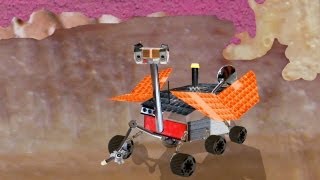(单词翻译:单击)
Today we're talking about weird materials that we use in space, in robots and in your mouth.
今天我们要讲一讲应用于于太空,机器人和你口腔中的奇特材料。
I'm talking about shape memory alloys.
我要讲的是形状记忆合金。
Like the name says, these are metals that remember different shapes.
就像名字所说,这是些记忆不同形状的金属。
To understand how these metals work, we've got to talk about atoms and organizing.
为了理解这些金属的工作原理,我必须谈一下原子和结构。
Let's talk about atoms first.
让我们先来讲一下原子。
Atoms are tiny bits of matter that you cannot see with your eye yet they make up everything in our world,
原子是一些你用眼睛无法观察到的微小物质,但是世间万物都是由它们组成的,
from the chair that you're sitting on to your cell phone.
从你正坐着的椅子到你的手机。
Atoms have some surprising ways of behaving too. We'll talk about that shortly. Now, how big is an atom?
原子同样有一些不可思议的表现。我们将简短地说一下。一个原子有多大?
Well, imagine pulling one of your hairs out of your head and whittling it like a stick 100,000 times.
想象一下从你头上拉一根头发,然后像削木头一样把它切10万次。
One of those shavings would be the width of an atom. They're that small.
那些削下来的片段才像原子一样宽。它们就那样小。
Now let's talk about atoms and organizing.
现在让我们来谈一谈原子和结构。
You may not know this, but atoms arrange themselves similar to the way we humans arrange ourselves.
你也许不知道这个,但是原子自己的排布就像我们人类组织自己一样。
Sometimes they sit in rows, like we do on a bus or an airplane.
有时候它们排成一行,就像我们在公交车或在飞机上。
We call that seating arrangement a phase.
我们称那个座次排列为“相”。
Other times they sit diagonal from each other, sort of like seats in a movie theater or sports stadium.
其他时候它们交错地排列,有点像在电影院或运动场的座位。
This is another phase. When atoms move from one seating to another this is called a phase change.
这是另一种“相”。当原子从一种座位排列变成另一种座位排列的时候,这就被称为“相变”。
Phase changes are all around us. You may already know about water's phases: solid, liquid and gas.
相变在我们身边无处不在。你也许已经知道水的“相”:固相,液相和气相。
Many other materials have phases like that too. Some of them have several solid phases.
许多其他的材料也有类似的“相”。其中一些拥有多个固态相。
OK. Back to those shape memory alloys we mentioned before.
好,回到我们之前提到的那些形状记忆合金。
When we say that the metals remember their different shapes,
当我们说金属记得它们不同的形状时,
what we're really saying is they remember different seating arrangements of atoms.
我们真正想说的是,它们记得原子的不同的座次排列。

When the atoms rearrange, the metal moves from one shape to another.
当原子重新排列的时候,金属就从一种形状转换到另一种形状。
Let's look at a phase change in action.
让我们看看反应中的相变。
Here I have a metal wire that is made out of nickel and titanium.
这里我有一根用镍和钛制成的金属导线。
This metal wire is a shape memory alloy, and I'm going to make it switch between its different shapes using heat from a lighter.
这种金属导线是一种形状记忆合金,我要用打火机的热量,让它在不同的形状之间转换。
Watch this. I'm going to wrap this wire around my finger and then heat it. Amazing!
瞧着:我要将这根导线缠在我的手指上,然后加热它。好神奇!
That wire returns to a straight line, when I heat it. Let's try that again.
当我加热它的时候,那根导线变回了一条直线。让我们再试一遍。
I'm going to wrap it around my finger, and heat it. Yep, that's still amazing.
我将把它缠在我的手指上并加热。是的,还是那么神奇。
Not only is it amazing, this is weird, because metals generally don't do that.
这不仅神奇,还很奇异,因为金属一般不会是那样的。
Here's a paper clip. When I heat it, I get nothing.
这是一根回纹针。当我加热它的时候,什么也没发生。
What we're seeing is the shape memory wire changing phases when it gets hot.
我们看见的是,记忆金属丝在受热时发生相变。
When the wire is cold, atoms are in a diagonal arrangement, like the movie theater seating, we talked about before.
当金属丝冷却时,原子交错排列,正如我们之间聊到的电影院座位一样。
We call this a monoclinic arrangement, and scientists will call this phase martensite.
我们称之为单斜晶系排布,科学家称之为马氏体。
When I heated up the wire, the atoms moved into columns like airplane seating.
当我们加热金属丝时,原子成列排布,像飞机座位一样。
This is a cubic arrangement. Scientists will call this phase austenite.
这是立方晶体排布,科学家称之为奥氏体。
So when we added the heat, the atoms shifted positions seamlessly, and they'll do this forever.
当我们继续加热,原子一点点移动,不断重复。
They have this coordinated motion, just like members of a tireless marching band.
他们这样协同移动,就像不知疲倦地行军的军乐队一样。
Each makes a small shift, but all together those small shifts create a totally different pattern.
每一个都改变一点,但当所有微小的改变加起来,就会形成一个完全不同的排列。
So that's pretty cool, but where do we use these materials?
这很酷,但我们可以把它应用到什么地方呢?
Well, if you look in the sky tonight, shape memory alloys are at work - on Mars.
如果你今夜仰望星空,记忆金属就在那工作着,在火星上。
They're used to move panels on the Mars rover, so that it can study the environment.
它们被用来调节火星车的太阳能板,使得火星车可以研究火星环境。
Like our metal straightened when it was heated, the metals holding the panels will move when electrically heated.
正如我们通过加热使金属变直一样,用于支撑平板的金属会由于电加热而移动。
When we stop heating the shape memory metal, the panel will return back, due to an opposing spring.
当我们停止加热记忆金属的时候,平板会在反方向弹簧的作用下弹回。
Back on Earth, shape memory alloys are used to open up clogged arteries as stents,
回到地球,记忆金属被做成动脉疏通术中的支架。
which are small collapsible springs that force open passages.
支架是一个小小的可折叠弹簧,用于撑开血管。
Shape memory alloys are also used to move robots, toy butterflies, teeth in braces,
记忆金属也被用于移动机器人,玩具蝴蝶,牙齿矫正,
and for a perfect fit every time, shape memory wires are used as underwires in bras.
以及为了每次都能完美贴身,记忆金属丝被用做胸罩的定型线。
Now you know Victoria's secret. By popping a bra into the dryer, it'll be brand new every time.
你知道维多利亚的秘密吧?当把胸罩放到烘干机中,它会变得焕然一新。
So whether it's on Mars or in your mouth, small atomic movements can create huge changes,
所以不论是在火星上还是在你的嘴里,小小的原子移动都能够产生巨大的变化,
and understanding the way atoms behave allows us to make materials that make our world a better place.
了解原子作用原理,可以让我们制造出改善世界的材料。


